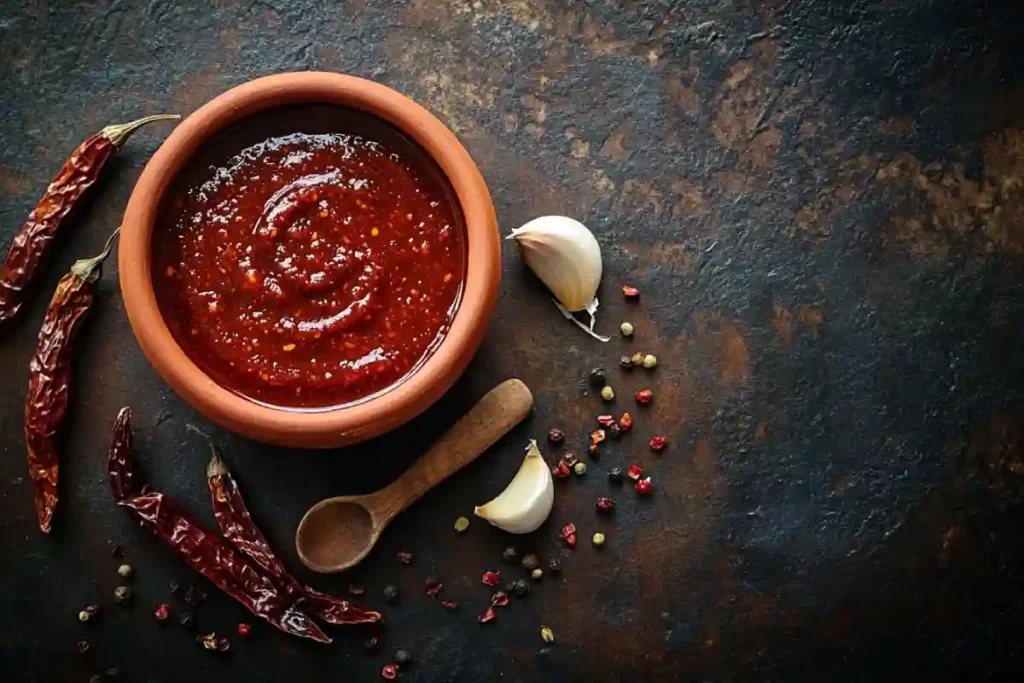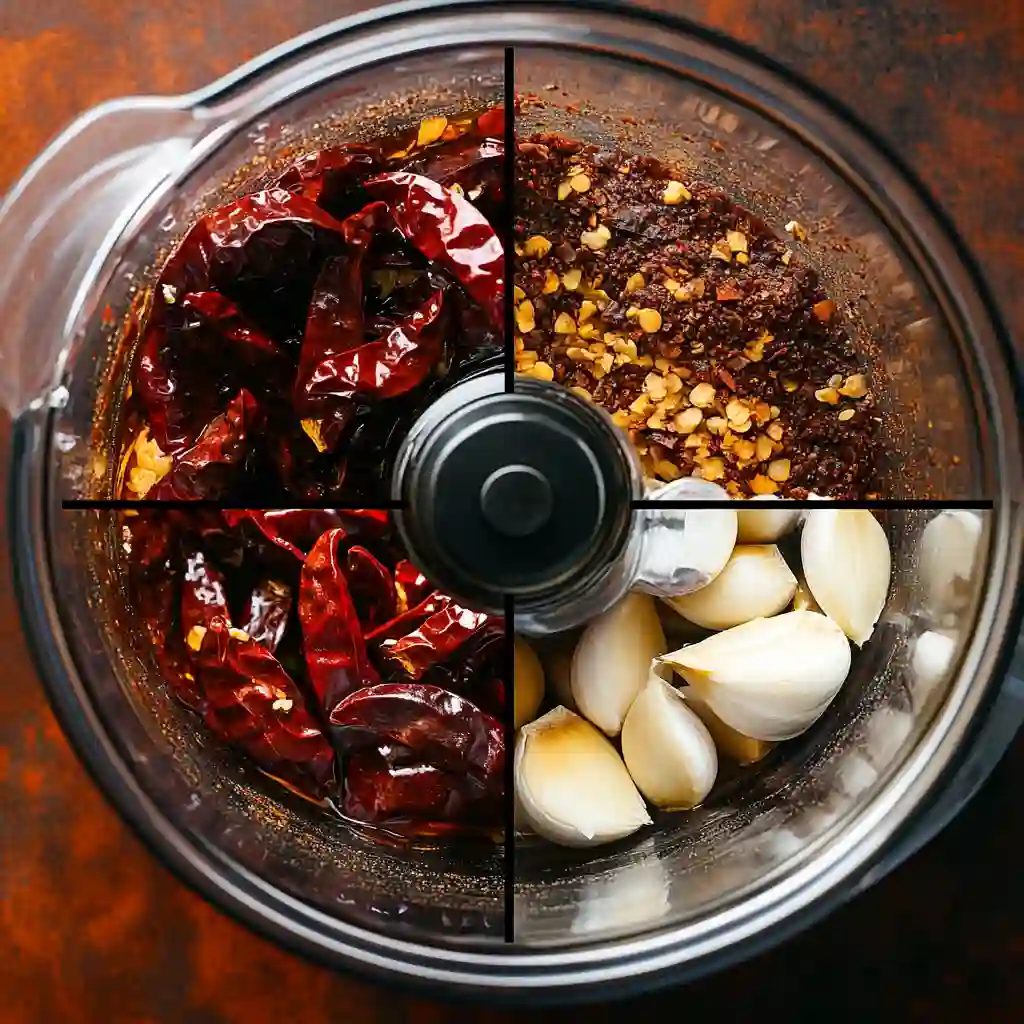
Table of Contents
If you’ve ever craved a sauce that hits deep with smoky, earthy warmth and just enough spice to make your tastebuds dance, then you’re in the right kitchen. This article dives into the bold flavors of ancho chili sauce, a rich condiment rooted in Mexican tradition but versatile enough for everything from tacos to tofu. I’ll walk you through my favorite way to prepare it, why it matters in plant-based cooking, and how it compares to other chili pastes. Whether you’re curious about ancho chili substitutes or just want a sauce that elevates your dishes naturally, we’ve got it simmering.
A Smoky Staple with a Backyard Twist
How I fell in love with ancho chili flavors
I never planned to fall in love with ancho chili. It just sort of happened one rainy Portland weekend while trying to fix a bland black bean stew. My pantry was mostly bare, except for a bag of dried ancho chili pods I’d picked up on a whim at a local co-op. They looked like crinkled raisins with an earthy aroma that reminded me of cocoa and sun-dried tomatoes. I soaked a few, blended them into a quick sauce with garlic and cider vinegar, and suddenly that humble stew turned into something bold, smoky, and seriously comforting.
That moment changed how I approached flavor in my plant-based kitchen. Ancho chili isn’t just about spice—it’s about body, depth, and warmth. Its mild heat carries a roasted sweetness that makes it ideal for sauces, marinades, and broths. And it’s not overpowering, which is key when cooking with subtle vegetables or proteins like tempeh or lentils.
Ever since, I’ve been crafting variations of ancho chili sauce—not just for tacos and enchiladas, but as a base for soups, a glaze for baked tofu, and even stirred into vegan mayo for an unforgettable sandwich spread. One of my go-to recipes is this smooth, deep-red ancho chili paste that I drizzle over roasted veggies or stir into chili for a boost of umami-rich complexity.
You can see how it shines in recipes like this ancho chili paste blend or learn to swap it in smartly with this detailed ancho chili substitute guide when you’re out of stock. These little adjustments not only save your dish but help you understand how essential ancho chili can be in plant-powered cooking.
Why ancho chili belongs in your everyday meals
What makes ancho chili so valuable isn’t just its flavor—it’s how versatile and affordable it is. Unlike hotter chiles, you can use ancho chili generously without overwhelming a dish. It blends beautifully with cumin, smoked paprika, and cinnamon, and plays well with sweet ingredients like maple or agave for sauces that feel both grounded and exciting.
It’s perfect in everyday staples like bean dips, tofu marinades, and even tomato sauces. My plant-based lentil loaf got a serious upgrade with a glaze made from pureed ancho, a splash of tamari, and a touch of balsamic. And if you’ve never tried it in soup? You’re missing out—especially in my carrot pasilla pepper soup where it adds a mellow complexity.
There’s something about ancho chili that reminds me of my dad’s backyard barbecue vibes—but reinvented through a lens of plants and clean flavor. It’s comfort food with soul. And as you build out your pantry, ancho chili becomes less of a specialty item and more of a weekly go-to, like garlic or olive oil.
Ingredients and Step-by-Step Preparation
Essential Ingredients for Ancho Chili Sauce
Making a truly flavorful ancho chili sauce starts with just a handful of simple, pantry-friendly ingredients. Each element plays a role in balancing smoky, tangy, and subtly sweet notes. For the best results, use dried ancho chilies that are soft and flexible—not brittle or cracked.

Here’s what you’ll need:
- 4 to 5 dried ancho chiles (about 2 oz)
- 3 garlic cloves, peeled
- 1 tablespoon apple cider vinegar
- 1 cup vegetable broth or filtered water
- 1 teaspoon cumin
- 1 teaspoon smoked paprika
- 1 tablespoon maple syrup (optional for depth)
- Salt, to taste
These ingredients combine to create a sauce that’s naturally plant-based, oil-free, and adaptable. You can make it richer, spicier, or even slightly sweet depending on your dish.
Cooking Process for Homemade Sauce
Creating your own ancho chili sauce is a satisfying process that takes less than 30 minutes. Here’s how to bring out the full potential of these richly flavored peppers:

- Clean the chiles: Remove the stems and most of the seeds from your ancho chiles. Tear each into two or three large pieces.
- Soak until soft: Place the chili pieces in a heatproof bowl and pour hot water over them. Cover and soak for 15–20 minutes until they’re soft and pliable.
- Blend everything: Drain the chilies and add them to a blender along with the garlic, vinegar, broth, cumin, smoked paprika, maple syrup, and a pinch of salt. Blend until smooth and creamy.
- Strain if desired: For an ultra-smooth sauce, press the blended mix through a fine mesh strainer to catch any chili skin or seeds.
- Taste and store: Adjust the salt to your liking. Store in a sealed glass jar in the fridge for up to 5 days, or freeze in small batches for future meals.
This foundational technique creates a versatile sauce you’ll find yourself reaching for throughout the week. For additional ideas or a more traditional take, check out this classic ancho chile sauce recipe from The Spruce Eats—a non-competitive, trusted culinary resource.
Delicious Ways to Use Ancho Chili Sauce
Plant-Based Meals That Love Ancho Chili Sauce
Once you’ve made a batch of ancho chili sauce, the real fun begins—using it to transform everyday meals. Its deep, smoky richness pairs beautifully with all kinds of plant-based ingredients, from hearty legumes to roasted vegetables. Below is a quick-reference table of my favorite uses.
| Dish Type | How to Use Ancho Chili Sauce |
|---|---|
| Tacos | Drizzle over lentil or mushroom fillings for a smoky finish |
| Grain Bowls | Use as a warm dressing for rice, quinoa, or farro bowls |
| Tofu or Tempeh | Marinate or glaze before baking for a flavor-packed crust |
| Soups | Stir into black bean or sweet potato soup for added depth |
| Burgers & Sandwiches | Mix into vegan mayo for a smoky sandwich spread |
Tips for Freezing and Pairing Flavors
This sauce stores well, which makes it even more practical for weekly meal prep. Here are some helpful tips for keeping it fresh and flavor-forward:
Freezing & Storing Tips
- Transfer into silicone ice cube trays and freeze in individual portions.
- Store in a sealed glass jar in the fridge for up to 5 days
- Reheat gently in a saucepan before serving
- Avoid overcooking after blending to retain its smoky aroma
Flavor Pairing Ideas
- Combine with citrus (like orange or lime) for brightness
- Pair with roasted garlic or caramelized onions
- Serve with corn-forward dishes like tamales or polenta
- Balance with sweetness—maple syrup or roasted carrots
Variations, Substitutes, and Nutritional Highlights
Nutritional Benefits of Ancho Chili
Don’t let the deep red color and smoky flavor fool you—ancho chili is as nutritious as it is flavorful. Derived from dried poblano peppers, it’s packed with antioxidants and mild heat compounds that support circulation and digestion.
Here’s a snapshot of the nutrition per 1 tablespoon of pure ancho chili powder:
That vitamin A content supports immune function and healthy skin—just one more reason to keep ancho chili in rotation.
Best Ancho Chili Substitutes for Cooking
Sometimes you run out of ingredients, or you want to change things up. If you don’t have ancho chili on hand, these are your best alternatives for maintaining a similar flavor profile:
- Pasilla chili – Slightly spicier, great for soups and sauces
- Guajillo chili – More tangy, good for salsas and enchiladas
- Chipotle powder – Adds heat and smoke, use in moderation
- Smoked paprika – Not a chili, but adds smoky depth in a pinch
- Mulato chili – Sweeter and more chocolaty, a great swap for richer sauces
For a full breakdown of which works best where, bookmark this ancho chili substitute guide which compares options based on flavor, spice, and usage.
Creative Variations Using Ancho Chili
If you’re already using ancho chili powder or paste, here are ways to build on that base and create your own signature blends:
- Mix with cocoa and cinnamon for a mole-style sauce
- Blend with roasted tomatoes and garlic for a taco base
- Combine with tamari, lime, and agave for a marinade
- Add to vegan mayo for a bold sandwich spread
- Mix into roasted veggie rubs or bean stews
Feeling adventurous? Try layering ancho chili into this earthy pasilla pepper overview or check out the rustic flavor possibilities in pasilla pepper salsa.
Frequently Asked Questions (FAQ)
What is ancho chile sauce?
Ancho chile sauce is a smooth, smoky, mildly spicy sauce made from rehydrated dried ancho chiles—dried versions of poblano peppers. It’s commonly used in Mexican cuisine for enchiladas, marinades, soups, and tacos, and works beautifully in plant-based cooking for depth and warmth.
Is ancho chili spicy?
Not particularly. Ancho chili is known for its mild heat, ranging from 1,000 to 2,000 Scoville units. Its flavor is more earthy, smoky, and slightly sweet—making it approachable for those sensitive to spice.
What is a substitute for ancho chili sauce?
If you’re out of ancho chili, you can use pasilla peppers, guajillo chiles, or even chipotle powder (in smaller amounts). Smoked paprika also works in a pinch, especially when blended with a little vinegar or tomato paste.
What do ancho chiles taste like?
Ancho chiles have a complex flavor—think dried fruit meets smoky barbecue. They offer subtle notes of coffee, cocoa, and sun-dried tomato, which make them a favorite for slow-simmered sauces and flavor-rich blends.
Conclusion
Whether you’re new to dried chiles or already have ancho chili in heavy rotation, there’s no denying its place in the plant-based kitchen. From its mild smoky warmth to its bold, adaptable personality, ancho chili is more than a flavor—it’s a foundation. Use it in sauces, soups, tacos, or stews, and let it transform your everyday meals into deeply satisfying dishes. It’s a pantry essential with rich roots and endless potential.
Keep experimenting, keep tasting, and keep turning to ancho chili when your meals need soul.
Print
Ancho chili sauce
- Total Time: 20 minutes
- Yield: 1.5 cups 1x
- Diet: Vegan
Description
This ancho chili sauce is bold, smoky, and easy to make. It’s plant-based, oil-free, and adds deep flavor to tacos, soups, and more.
Ingredients
4 to 5 dried ancho chiles (about 2 oz)
3 cloves garlic, peeled
1 tablespoon apple cider vinegar
1 cup vegetable broth or water
1 teaspoon cumin
1 teaspoon smoked paprika
1 tablespoon maple syrup (optional)
Salt to taste
Instructions
1. Remove stems and seeds from ancho chiles.
2. Soak chiles in hot water for 15–20 minutes until soft.
3. Drain and add to a blender with garlic, vinegar, broth, spices, and maple syrup.
4. Blend until smooth.
5. Strain sauce through a fine mesh sieve for extra smoothness.
6. Season with salt to taste. Store in fridge or freeze in small portions.
Notes
For extra depth, use vegetable broth instead of water.
Pairs well with roasted veggies, tofu, or tacos.
- Prep Time: 10 minutes
- Cook Time: 10 minutes
- Category: Sauce
- Method: Blended
- Cuisine: Mexican
Nutrition
- Serving Size: 2 tbsp
- Calories: 14
- Sugar: 1g
- Sodium: 60mg
- Fat: 0g
- Saturated Fat: 0g
- Unsaturated Fat: 0g
- Trans Fat: 0g
- Carbohydrates: 3g
- Fiber: 2g
- Protein: 0g
- Cholesterol: 0mg
Keywords: ancho chili, ancho chili sauce, plant-based sauce, vegan sauce
